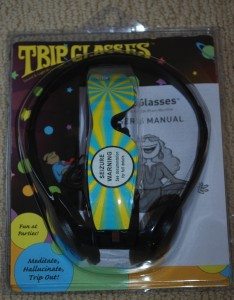 At first glance Cornfield Electronics’ Trip Glasses look like a throwback to the X-Ray specs offered in the back pages of comic books. Despite cartoons showcasing the lascivious properties of the specs, they didn’t actually do anything, whereas Trip Glasses purport to bring the user on a crazy head trip. It’s not called a “brain machine” just for kicks! When the glasses are on and activated, dual tones play out of the attached headphones while red lights repeatedly flashes in the lenses of the glasses. These combined stimuli are supposed to cause your brain to see images and colors as well as relax your entire body. But does it really work? More on that in a bit.
At first glance Cornfield Electronics’ Trip Glasses look like a throwback to the X-Ray specs offered in the back pages of comic books. Despite cartoons showcasing the lascivious properties of the specs, they didn’t actually do anything, whereas Trip Glasses purport to bring the user on a crazy head trip. It’s not called a “brain machine” just for kicks! When the glasses are on and activated, dual tones play out of the attached headphones while red lights repeatedly flashes in the lenses of the glasses. These combined stimuli are supposed to cause your brain to see images and colors as well as relax your entire body. But does it really work? More on that in a bit.
In the package are the glasses, headphones, instructions, and white oval stickers. The stickers are for placing over the red flashing lights to reduce the brightness. Even though the user is instructed to use the glasses with closed eyes, the lights are still very bright. For very sensitive eyes, it’s suggested that two or more stickers can be used over each light.
The glasses are made of black hard plastic with a “trippy” design sticker on the front. The instructions mentioned this is removable, but I couldn’t easily take it off without leaving a sticky residue behind. There are small holes in the center of each lens where the red lights will blink. The headphones are about on par with the quality you find included with a generic walkman or what is given to you on an airplane. They rest on the ear rather than over. Luckily, they are not permanently attached and a swap with your own preferred set of cans will make your “trip” much more pleasant.
Using the glasses is pretty simple–put the glasses and headphones on, close your eyes, and press the on button located on the frame of the glasses. This initiates the 14 minute cycle of sound and flashing red lights. A very long 14 minutes. According to the site’s FAQ you could use the device for as long or as short as you’d like and still receive an effect. Unfortunately, there is no off button; the glasses shut off only after the full cycle.
But there actually is a bit of science behind the glasses that I’m going to try to summarize without butchering too poorly. The glasses “work” off of the use of binaural beats, where two tones of slightly different frequencies are played in each ear. The brain processes this as a single mixed “phantom” tone. Binaural beats are thought to have the ability to induce pain relief and relaxation and will supposedly even work at frequencies below the human range of hearing. If the science interests you, there are open source (and free) binaural beat generators available on the Internet that will have the same effect as these glasses.
This was a very difficult product to review. Not really knowing what to expect, I put the glasses and headphones on and after about fifteen seconds of extreme discomfort, I threw them off. For me it felt like I was staring at a strobe light and the audio (for which there is no volume control) sounded like the tone that plays over color bars when a TV station goes off the air. My brain wanted nothing to do with it. Trip Glasses sell for about $40 through ThinkGeek and the manufacturer, which feels a little pricey for what you actually get in hand. As the saying goes, beauty is in the eye of the beholder, so for some this may be quite a cool little machine. For me though, it was a migraine-inducing miss.
Gerber Gear Suspension 12-in-1 EDC Multi-Plier Multitool with Pocket Knife, Needle Nose Pliers, Wire Cutters and More, Gifts for Men, Camping and Survival, Grey
25% OffCAMVATE Folding 6-in-1 Multi-Tool Kit(Blue)-3801
$9.90 (as of December 8, 2025 21:48 GMT -05:00 - More infoProduct prices and availability are accurate as of the date/time indicated and are subject to change. Any price and availability information displayed on [relevant Amazon Site(s), as applicable] at the time of purchase will apply to the purchase of this product.)Product Information
| Price: | $39.99 |
| Manufacturer: | Cornfield Electronics |
| Retailer: | ThinkGeek |
| Pros: |
|
| Cons: |
|

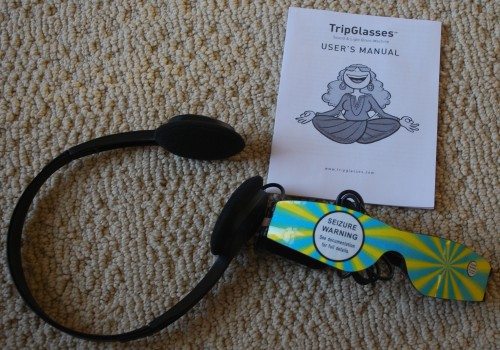
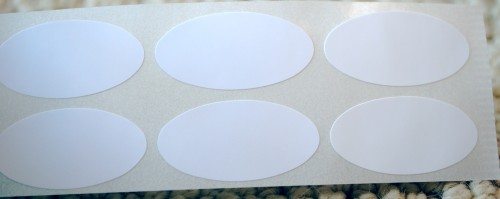
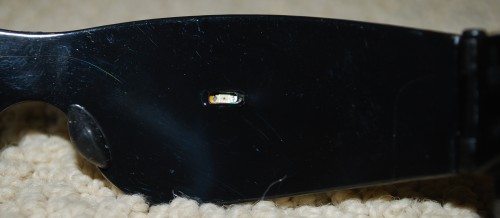
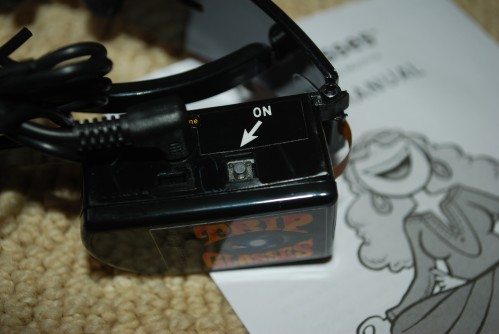


Gadgeteer Comment Policy - Please read before commenting
Similar products to this have been around for years. A properly functioning pair will make you relaxed and put you in an alpha wave state. These sound cheap and poorly made. Bummer!
Well, the science behind it definitely sounds interesting. During my review period I had downloaded an application called iDoser to see if that would be a better trial run than the glasses, but I didn’t feel much from it either. Maybe I just don’t have the attention span to sit still and listen to repetitive noises 😉
Sounds interesting – might try and give the application Morgan has spoken about a go, to see how it works first …
Yeah, I can confirm about the iDoser – despite the awesome names and descriptions of the various available “doses”, I didn’t feel anything that I didn’t make conscious efforts to imagine feeling. It was all just repetitive noise.
i-doser works very well, be patient with it ,
average people complain about these things very quickly
Just wanted to say I got a pair of these from cornfield. loved them. they aren’t made the best: start/stop button doesn’t work from first use, so I have to remove the battery and put it in to use it. I’ve only used it twice, but it impressed me very much. I let a co-worker (ex-hippie, used to “tune-in” quite often) borrow these, he loved them and ordered a pair for himself and an old buddy of his. Two thumbs up on the experience, two thumbs down on the build quality. I used them at about 9PM at night, went to bed around 11, had lucid dreaming session for awhile. Lucid dreaming isn’t something that normally happens to me, and thus I’m presuming to be an after-effect from the glasses.
First off, you are supposed to close your eyes with them, not sure if the reviewer did. 15 seconds is not long enough, you have to settle into them. I love them but NOT for everybody. I did not but them to “relax”, but rather to experience trippy images and they can deliver that in spades if you stay open to it. Also moments of feeling like “flioating”. Yes, other “things” can help accentuate the experience. I also recommend using a stereo mini cable out of the headphone jack and into a suitable headphone amp, then you can control (and increase) the headphone level (and use nice headphones). Also fun to play music with them, guess you won’t get the supposed brain wave effects, but you can still get fleeting trippy images (geometric spinning discs heading at you, demon faces, multiple eyes, crystal palaces, a sense of floating in a cavernous space) to accompany your soundtrack. I’m exaggerating a little, but you can see some weird stuff if you relax into it. May seem cheaply made, but look into making them yourself (I did), and you’ll find you end up spending maybe $10 or $15 less for parts, plus your time to put them together. I have other DIY projects to spend my time on, so I dropped the $40 on these. Fun when I’m in the mood!
I made these glasses in the very same way. The nly diffrence is i used. The TiP31 sound to light circuit to control the led flashing rate. Now i can connect the glasses to my mp3 player and enjoy a trip of my own. Not tested them as yet.
Thanks for the review of these. I read it way back when I was contemplating purchase of same.
I’ve been following Mitch Altman for many years now and have ordered a few TVBGone units for me, family, and friends.
His company had a 25%-off sale a while back, but I failed to pull the trigger, so when I caught wind of a 50%-off Labor Day weekend sale on Trip Glasses, I ordered a pair.
I got them yesterday, tried them out, and for the first few seconds, just saw a blurry pattern of red and blue lights, so I thought I’d wasted my money.
But a few seconds later, the sound changed a little bit and the images I was “seeing” (imagining?) changed to something totally different. It was like the changing sounds were changing the images I was visualizing. And I was “seeing” different shapes, different colors (sometimes no colors, just gray), different patterns, etc. I think I even saw a few spirals. Very cool.
I tried it again for a few minutes before going to sleep and had a similarly enjoyable experience. (I hadn’t thought about my dreams last night until I read Tom’s comment above and realized that I had slightly more vivid/lucid dreams than normal, so I, too, would attribute that to my use of the Trip Glasses.)
As predicted, for me, the lights were very bright, so I applied an included oval sticker over each LED and I’ll see how that goes later today.
As for the sticker removal that Morgan mentioned in the article, it sounds like there may have been some confusion. My instruction manual mentions removing the (round) seizure-warning stickers (which I promptly did). It took some light scraping to create an edge to lift, but once I did, they peeled off just fine, no residue. Morgan seemed to have removed the “trippy” stickers from the glasses themselves; I don’t think the instructions were suggesting that those be removed.
Anyway, while they are a little flimsy and I’ll be storing them in the shipping box, I’m glad I bought them and, knowing what I know now, I think I’d have bought them at full-price, too.
@Andy D – thank you for your feedback! There are been a few comments on the review since it was posted disagreeing with my assessment and that’s extremely valuable to both me and the readers. This is one of those products where you either “get” it or you don’t. I think I had gone into my product review and testing with a preconceived idea of how they would work and so the bright lights and the buzzing tones really irritated me. I’m very sensitive to sound, and the repetitive nature of the tones just drove me crazy 🙂 But I’m happy to read about your experience, I wish I could have had the same; it sounds very interesting!